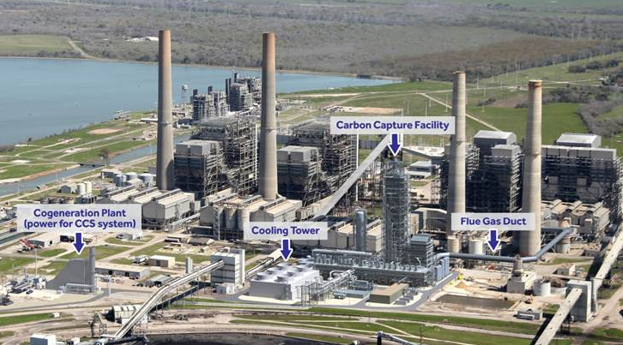What is carbon capture and storage and its environmental risks

Written by Nell Cormack August 2022, edited by Katie Edwards, Robert Routh, Alex Bomstein
Supporters of hydrogen derived from fossil gas have claimed it can be a leading part of the clean energy future because of the possibility of pairing it with carbon capture and storage (CCS) technology, often referred to as carbon capture, utilization, and storage (CCUS). The fossil fuel industry advertises CCS as a way to mitigate the carbon emissions produced by burning fossil fuels to power hydrogen production.
In fact, carbon capture has been utilized by the fossil fuel industry for decades in the form of enhanced oil recovery (EOR), the process of compressing carbon dioxide to increase its density and then injecting the high-density carbon dioxide into oil reservoirs. Once injected into the reservoir, the carbon dioxide mixes with any trapped oil, which is then pumped out of the reservoir, increasing the amount of oil that can be obtained from the reservoir (and, consequently, increasing carbon emissions that result when that oil is burned). This is most commonly what companies mean when they refer to the “U” in CCUS.
While EOR has been around for quite a while, the idea of capturing carbon and storing it to reduce the impacts of climate change has only recently gained some traction among industry and governments worldwide. This idea involves capturing carbon dioxide, compressing it to a high density, transporting it, usually via pipeline, and storing it in geological formations deep underground. Carbon dioxide can be captured from emissions of industrial processes and even captured directly from the air. That direct air capture, or “carbon dioxide removal,” is in its early technological stages and is intended to be carbon negative, rather than traditional CCS which attempts to capture and reduce the amount of CO2 emitted directly from a source burning fossil fuels (making it carbon neutral, at best).
Carbon dioxide can be captured from flue gas streams with a variety of methods, but the most commonly used methods are chemical absorption, which uses a chemical solvent, and physical separation, which uses a solid surface like activated carbon to capture the carbon dioxide. After carbon dioxide has been captured, it must be transported via pipeline to a storage site.
Blue Hydrogen is Not Clean Energy
While the U.S. Department of Energy (DOE) announced in February $28 million in funding for projects involving fossil fuel-based hydrogen with CCS under the label of “clean hydrogen” (Pennsylvania will most likely seek to deploy what’s often referred to as “blue hydrogen”), it is anything but inherently clean or free from environmental risk. When carbon dioxide is transported through pipelines to storage sites, it must be transported at very low temperatures and high pressure, increasing the risk to communities and the environment surrounding the pipelines if there is a leak. A Mississippi carbon dioxide pipeline rupture in February 2020 resulted in dozens of hospitalizations and evacuations of hundreds of nearby residents. Many carbon dioxide pipelines would likely be built in marginalized communities already heavily burdened by pollution as these areas contain high concentrations of oil and gas as well as potential storage sites for carbon dioxide.
Even without the environmental risks, CCS has not proven effective at capturing carbon. As of July 2021, existing CCS facilities captured less than 1% of carbon dioxide emissions annually. Of that amount, only 19% of carbon dioxide was actually stored underground, while the remaining was used for EOR.
Additionally, hydrogen production with CCS is currently not economically viable. The Quest facility, a CCS project operated by Shell in Canada that produces hydrogen from fossil gas (sometimes referred to as “natural gas,” and which is primarily composed of methane, an extremely potent greenhouse gas), currently captures carbon at $63.70 per ton at capture rates below 85%. For capture rates above 85%, studies estimate the cost would be between $80 and $100 per ton of carbon captured. For CCS to be economically feasible, costs must be reduced to around $27 per ton by 2030, meaning cost must be reduced by over half in a few short years.
Advocates of hydrogen with CCS emphasize its potential role in hard-to-decarbonize industries like steel and cement. But in order for hydrogen with CCS to have a place in the green economy future, emphasis must be placed on increasing carbon capture efficiency while ensuring the environmental risks are minimized. If Pennsylvania becomes the site of one of the proposed regional hydrogen hubs, hydrogen would almost certainly be generated with fossil gas. The KeyState to Zero project, a proposed gas facility in Clinton County that is set to become a combined gas extraction, chemical/hydrogen production, and CCS site, expects to begin construction as early as next year. This would make it Pennsylvania’s first commercial project featuring hydrogen produced with CCS. Fossil-fuel based hydrogen is not the way to propel Pennsylvania to a cleaner, safer future. If hydrogen is to be part of the energy economy, any related lifecycle emissions must be reduced as much as possible.
Ultimately, fossil-fuel based hydrogen production with CCS runs the serious and unacceptable risk of prolonging the use of fossil fuels instead of focusing on decarbonization through the use of renewable energy sources. With blue hydrogen’s high costs, inefficiency, environmental risks, and continuation of fossil fuel reliance, investing in renewable energy sources that are becoming significantly cheaper remains the best option to reach a zero carbon future.

